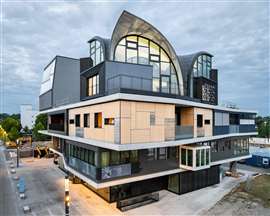Implenia announces net-zero build
12 January 2024
Implenia will partner with two Swiss institutes on construction and planning for ‘Beyond Zero’, one of the cooperative’s newest net-zero NEST research platforms
 The NEST building at Empa. The new “Beyond Zero” unit will be built on the centre platform. (Photo credit: Roman Keller)
The NEST building at Empa. The new “Beyond Zero” unit will be built on the centre platform. (Photo credit: Roman Keller)Empa (Swiss Federal Laboratories for Materials Science and Technology) and Eawag’s (the Swiss Federal Institute of Aquatic Science and Technology) NEST unit is a modular research and innovation building.
In the building, “new technologies, materials and systems are tested, researched, further developed and validated under real conditions,” according to the collaborative.
The Beyond Zero unit is designed to use CO2-reduced and CO2-negative innovations in the building sector in hopes of showing how buildings can act as carbon sinks (or help remove carbon from the atmosphere).
The build will use materials like magnesium-based cement and clay bricks, as well as insulation made from biochar and concrete enriched with biochar.
“These materials include thermal insulation and cements that bind carbon dioxide in the air, as well as clay-based bricks that do not require firing,” confirmed Implenia.
Developed by Empa, the institution believes these innovations can help the construction industry reach net-zero building goals.
“The Beyond Zero unit goes one step further and pursues the vision that buildings can serve as carbon sinks in the future – meaning that they will have a negative carbon footprint overall,” stated Empa.
Beyond Zero is currently in the planning phase, but the Empa director, Prof. Tanja Zimmermann, noted Implenia’s recent successes with sustainable builds.
“Implenia has built some pioneering sustainable buildings on the Empa Campus in Dübendorf, [Switzerland], most recently a laboratory and office building, as well as the first multi-story car park in Switzerland to use a timber-hybrid construction method,” said Zimmermann. “
What is a net-zero building?
A net-zero building, or net-zero energy building, is a structure that can equal its total amount of energy used annually to its on-site renewable energy production.
In addition to using energy sources like solar power, current net-zero buildings also use innovative insulation and materials to offset carbon emissions both during construction and through the structure’s lifespan.
Architecture and design are also key, as many net-zero buildings utilise spaces engineered to encourage air flow and/or temperature stability.
The Empa and Eawag NEST site is unique, in that, the habitats are specifically designed to be studied and create a blueprint for future sustainable construction and development. The Beyond Zero platform is ambitious, as it hopes to pull even more carbon from the atmosphere than it produces.
“The construction and operation of the unit is intended to provide insights into the role that buildings can play in achieving the net-zero goal and beyond in the future,” said Empa.
Is net-zero possible?
There are no doubt successful net-zero projects across the globe, however, as KHL’s Neil Gerrard reported in December, of the many buildings constructed around the world touted as “net-zero”, very few of them are in operation.
In a 2023 report from Arup and the World Business Council for Sustainable Development, it stated that the goal of 100% net-zero operations is “out of reach for the vast majority of buildings.”
Many corporations have taken to using the term “near net-zero” to describe projects that aim to greatly reduce a structure’s carbon footprint as opposed to eliminating it.
Government interest
Despite the semantics, governments across the globe have been pushing for net-zero (or near net-zero) projects.
The Defense Innovation Unit (DIU), an organisation with the US Department of Defense (DOD), announced early this month it was seeking proposals on near net-zero projects.
The agency is requesting vendors with methods to improve energy and water efficiency in newer DOD facilities.
In particular, the DIU wanted builders to use materials with a “low” climate impact.
On a larger scale, the UK recently announced an enhanced commitment to nuclear energy, which the government said puts the country on track to be net-zero by 2050.
Public and corporate interest
It’s not just administrations attracted by net-zero, according to a recent report, net-zero energy buildings are expected to see 29% growth through 2027.
“Governments, corporations, and society at large recognize the pivotal role buildings play in reducing emissions and energy use,” said Dominique Bonte, Vice President of End Markets at ABI Research.
ABI Research expects 5500 commercial and residential net-zero building projects globally by 2027. There were 1200 in 2022.
STAY CONNECTED



Receive the information you need when you need it through our world-leading magazines, newsletters and daily briefings.
CONNECT WITH THE TEAM








